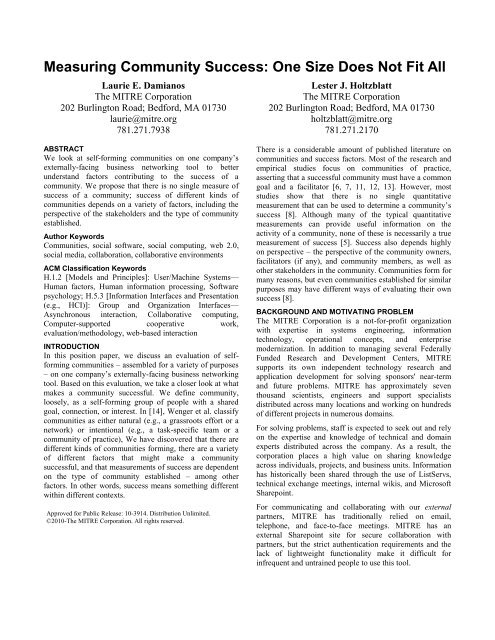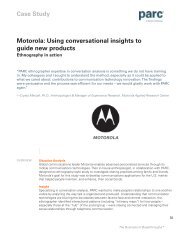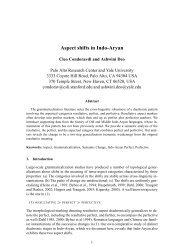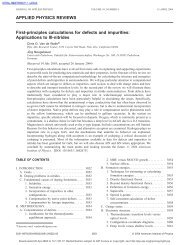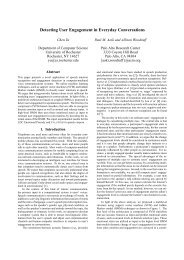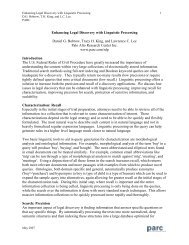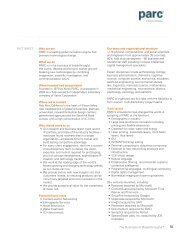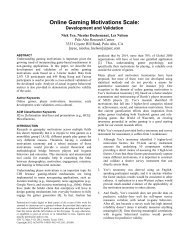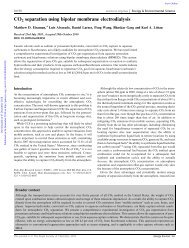Measuring Community Success: One Size Does Not Fit All - Parc
Measuring Community Success: One Size Does Not Fit All - Parc
Measuring Community Success: One Size Does Not Fit All - Parc
You also want an ePaper? Increase the reach of your titles
YUMPU automatically turns print PDFs into web optimized ePapers that Google loves.
<strong>Measuring</strong> <strong>Community</strong> <strong>Success</strong>: <strong>One</strong> <strong>Size</strong> <strong>Does</strong> <strong>Not</strong> <strong>Fit</strong> <strong>All</strong><br />
Laurie E. Damianos<br />
The MITRE Corporation<br />
202 Burlington Road; Bedford, MA 01730<br />
laurie@mitre.org<br />
781.271.7938<br />
Lester J. Holtzblatt<br />
The MITRE Corporation<br />
202 Burlington Road; Bedford, MA 01730<br />
holtzblatt@mitre.org<br />
781.271.2170<br />
ABSTRACT<br />
We look at self-forming communities on one company’s<br />
externally-facing business networking tool to better<br />
understand factors contributing to the success of a<br />
community. We propose that there is no single measure of<br />
success of a community; success of different kinds of<br />
communities depends on a variety of factors, including the<br />
perspective of the stakeholders and the type of community<br />
established.<br />
Author Keywords<br />
Communities, social software, social computing, web 2.0,<br />
social media, collaboration, collaborative environments<br />
ACM Classification Keywords<br />
H.1.2 [Models and Principles]: User/Machine Systems—<br />
Human factors, Human information processing, Software<br />
psychology; H.5.3 [Information Interfaces and Presentation<br />
(e.g., HCI)]: Group and Organization Interfaces—<br />
Asynchronous interaction, Collaborative computing,<br />
Computer-supported cooperative work,<br />
evaluation/methodology, web-based interaction<br />
INTRODUCTION<br />
In this position paper, we discuss an evaluation of selfforming<br />
communities – assembled for a variety of purposes<br />
– on one company’s externally-facing business networking<br />
tool. Based on this evaluation, we take a closer look at what<br />
makes a community successful. We define community,<br />
loosely, as a self-forming group of people with a shared<br />
goal, connection, or interest. In [14], Wenger et al. classify<br />
communities as either natural (e.g., a grassroots effort or a<br />
network) or intentional (e.g., a task-specific team or a<br />
community of practice), We have discovered that there are<br />
different kinds of communities forming, there are a variety<br />
of different factors that might make a community<br />
successful, and that measurements of success are dependent<br />
on the type of community established – among other<br />
factors. In other words, success means something different<br />
within different contexts.<br />
Approved for Public Release: 10-3914. Distribution Unlimited.<br />
©2010-The MITRE Corporation. <strong>All</strong> rights reserved.<br />
There is a considerable amount of published literature on<br />
communities and success factors. Most of the research and<br />
empirical studies focus on communities of practice,<br />
asserting that a successful community must have a common<br />
goal and a facilitator [6, 7, 11, 12, 13]. However, most<br />
studies show that there is no single quantitative<br />
measurement that can be used to determine a community’s<br />
success [8]. Although many of the typical quantitative<br />
measurements can provide useful information on the<br />
activity of a community, none of these is necessarily a true<br />
measurement of success [5]. <strong>Success</strong> also depends highly<br />
on perspective – the perspective of the community owners,<br />
facilitators (if any), and community members, as well as<br />
other stakeholders in the community. Communities form for<br />
many reasons, but even communities established for similar<br />
purposes may have different ways of evaluating their own<br />
success [8].<br />
BACKGROUND AND MOTIVATING PROBLEM<br />
The MITRE Corporation is a not-for-profit organization<br />
with expertise in systems engineering, information<br />
technology, operational concepts, and enterprise<br />
modernization. In addition to managing several Federally<br />
Funded Research and Development Centers, MITRE<br />
supports its own independent technology research and<br />
application development for solving sponsors' near-term<br />
and future problems. MITRE has approximately seven<br />
thousand scientists, engineers and support specialists<br />
distributed across many locations and working on hundreds<br />
of different projects in numerous domains.<br />
For solving problems, staff is expected to seek out and rely<br />
on the expertise and knowledge of technical and domain<br />
experts distributed across the company. As a result, the<br />
corporation places a high value on sharing knowledge<br />
across individuals, projects, and business units. Information<br />
has historically been shared through the use of ListServs,<br />
technical exchange meetings, internal wikis, and Microsoft<br />
Sharepoint.<br />
For communicating and collaborating with our external<br />
partners, MITRE has traditionally relied on email,<br />
telephone, and face-to-face meetings. MITRE has an<br />
external Sharepoint site for secure collaboration with<br />
partners, but the strict authentication requirements and the<br />
lack of lightweight functionality make it difficult for<br />
infrequent and untrained people to use this tool.
CASE STUDY<br />
Through MITRE’s research program, a team developed and<br />
launched Handshake [1], a business networking prototype<br />
based on Elgg, an open source platform [2]. The Handshake<br />
prototype provides a MITRE-owned space for connecting,<br />
collaborating, and networking with both internal and<br />
external partners in a trusted environment as well as a<br />
research platform for exploring the value of social media in<br />
the enterprise.<br />
Handshake is open to all MITRE employees. Members can<br />
connect with each other, create a profile, and establish<br />
groups for any purpose. MITRE staff must explicitly invite<br />
external participants to join Handshake, but these external<br />
partners can, in turn, establish connections with other<br />
Handshake members and join groups.<br />
Groups may be open to all members of Handshake, limited<br />
to MITRE employees, or restricted to a named subset of<br />
members. Groups with moderated access require approval<br />
for members to join; in open groups, members can self join.<br />
Available group tools include a discussion forum, a file<br />
repository, wiki-like ―pages,‖ blogs, photo albums, and a<br />
message board (see Figure 1). Each piece of content within<br />
a group inherits the corresponding group permission but<br />
may also be restricted further (e.g., MITRE members of the<br />
group).<br />
A group owner may appoint one or more co-owners to have<br />
group administration rights. Owners and co-owners can add<br />
or remove members from the group, change the group<br />
access controls, edit group metadata (e.g., tags, related<br />
URLs, description, title), or delete any inappropriate<br />
content.<br />
Awareness of activity on Handshake is provided through<br />
activity streams and customizable email alerts. Email alerts<br />
provide profile information on the creator of the content,<br />
the content itself, and quick links into Handshake.<br />
At the time of the study, Handshake had been available for<br />
just over one year. There were approximately 3300<br />
registered members, including 800 external participants,<br />
and 300 established groups. MITRE use of Handshake was<br />
voluntary, as was the creation of each of the groups.<br />
Figure 1A Handshake Group consists of a message board, discussion forum, file repository, blog, wiki-like pages, albums, and an<br />
activity feed to provide awareness and history. Commenting allows discussions in context.
APPROACH<br />
For this study, we looked at 243 groups that had been<br />
created within a one-year period. Most of the groups were<br />
still in the growth stage [4] and had not yet reached<br />
maturity. We did not look at newly created groups because<br />
they were too new to have established regular usage<br />
patterns. We also omitted test groups and hidden groups<br />
that had no members.<br />
Most of the groups examined were moderated and restricted<br />
to group members. On average, MITRE employees<br />
represented 87% of group membership although 12% of<br />
those groups had less than 50% MITRE employees as<br />
members with a few of them almost exclusively made up of<br />
external partners. Some groups had up to 6 co-owners, but<br />
the median was just one per group. The median size of each<br />
group was 11, with 977 members belonging to the largest<br />
group (open to <strong>All</strong> MITRE).<br />
We created a short survey that was distributed to 222<br />
owners and co-owners of the 243 groups. We asked 6<br />
questions about the purpose/goal/objective of the group,<br />
how they would categorize their group, whether there was a<br />
designated facilitator, how they rated the success of their<br />
group on a 5-point Likert scale, what factors they<br />
considered in evaluating the success, and what other tools<br />
they used to support this group. We gave the participants 3<br />
days to respond to the survey. At the end of the second day,<br />
we sent a reminder to those who had not yet responded.<br />
We had 81 participants respond with their input on 128<br />
groups (108 unique groups). For those groups with multiple<br />
respondents, we combined their responses and resolved<br />
minor conflicts by averaging scores and making judgment<br />
calls on group category. Some survey recipients chose not<br />
to participant but indicated to us that their groups had not<br />
been successful.<br />
The categories used in the survey (see Table 1) had been<br />
pre-created by classifying each group based on its<br />
description. These categories map closely to the corporate<br />
categories used for the internal Sharepoint site although, for<br />
this survey, we added <strong>Community</strong> of Interest and<br />
Affiliation, types of communities not found on the<br />
Sharepoint site.<br />
In addition to survey results, we collected data from the<br />
Handshake database and performed some basic calculations<br />
(see Table 2). Examining the group activity by month over<br />
time, we then classified the activity as consistent (moderate<br />
to high), consistent (low), and little to no activity.<br />
INITIAL RESULTS AND DISCUSSION<br />
Over half the groups established on Handshake were either<br />
Projects (both internal and cross-organizational) or<br />
Communities of Practice (COP). See Figure 2.<br />
Some types of groups were more likely to be rated as<br />
successful by the group owners than other types of groups<br />
(Figure 3). <strong>One</strong> possible explanation for these results is that<br />
success is dependent on the clarity of the community’s<br />
mission or goal [8]. Projects and Conferences have clear<br />
goals and objectives whereas Programs, Organizations, and<br />
Affiliations typically do not have stated tasks or objectives.<br />
The goals of COPs or COIs may be fuzzier than the goals of<br />
Projects but more clear than that of Organizations.<br />
Category<br />
<strong>Community</strong> of<br />
Practice (COP)<br />
<strong>Community</strong> of<br />
Interest (COI)<br />
Project<br />
Program<br />
Council<br />
Organization<br />
Affiliation<br />
Conference /<br />
TEM<br />
Other<br />
Definition<br />
A group of people who share a common<br />
domain, field, or profession<br />
A group of people who share a common<br />
interest or passion, not directly related to<br />
their work<br />
A team of individuals collaborating on a<br />
funded project with a MITRE project<br />
number, or a work team for an assigned<br />
group project<br />
People comprising an area of work that<br />
encompasses different projects<br />
A task or advisory-level group of people<br />
chartered at the corporate, center, or<br />
enterprise-level, usually crossorganizational<br />
A MITRE organizational unit; e.g., a<br />
department or division<br />
A group of people who share a common<br />
past or present association with an<br />
organization such as a university,<br />
company, or professional association<br />
A group of people attending a specific<br />
event (may be a recurring event)<br />
(Survey participant as asked to define)<br />
Table 1 Group Categories<br />
Fewer groups had designated facilitators, but having a<br />
facilitator did not appear to be a factor of community<br />
success (see Figure 4).<br />
The overall level of group activity appears to predict the<br />
community’s success (Figure 5). Groups with a consistent<br />
level of moderate to high activity were more likely to be<br />
rated as successful. This finding also holds true across types<br />
of content in groups; successful communities were engaged<br />
in more discussions, contributed more files, and created<br />
more pages than unsuccessful ones (Figure 6). Indeed,<br />
success criteria enumerated by survey participants typically<br />
included generation of artifacts, amount of shared content,<br />
quality of conversations, and ongoing activity.
Metrics & Calculations<br />
Group membership<br />
model<br />
Group permissions<br />
Group creation date / #<br />
days in existence<br />
# owners/co-owners<br />
<strong>Not</strong>es<br />
e.g., open/moderated<br />
e.g., <strong>All</strong> Handshake, <strong>All</strong><br />
MITRE, Group only, My<br />
Connections<br />
# members This final number was pulled<br />
only at the time of the study.<br />
We were unable to ascertain<br />
member join date or whether<br />
people had joined and then left.<br />
% MITRE members<br />
# & type of group<br />
content<br />
# comments on each type<br />
of content<br />
Median/max thread<br />
depth<br />
e.g., discussion topics, blog<br />
posts, files, pages, albums<br />
% contributors Those who contributed original<br />
content and may also have<br />
made comments<br />
% commenters Those who commented but did<br />
not contribute original content<br />
% lurkers Those who did not participate<br />
in any group activity<br />
Group activity by month<br />
Based on amount of content &<br />
comments<br />
Table 2 Handshake Data Used in Study<br />
However, the type of activity a community engaged in<br />
differed across group category (Figure 7). Comparing the<br />
four most frequently occurring categories: Projects, COPs,<br />
COIs, and Organizations, we see that<br />
Projects were more likely to create/edit pages. This is<br />
consistent with the observation that project groups<br />
work collaboratively around an artifact.<br />
COPs and Projects were equally likely to upload files<br />
and much more likely to do so than COIs or<br />
Organizations.<br />
COIs and COPs were equally likely to post discussion<br />
topics and much more likely to do so than Projects or<br />
Organizations. However, the depth of discussions in<br />
COIs is greater than in COPs.<br />
From a separate interview study, we learned that lurking<br />
(not actively contributing to group content) may actually be<br />
an active behavior, and that lurkers may highly value a<br />
community because of what they learn. These findings are<br />
consistent with the conclusions of other researchers who<br />
view lurkers as valued participants in online communities<br />
[9]. Because of the negative connotations often associated<br />
with the term ―lurker‖, Preece and Schneiderman [10]<br />
suggest that the term ―reader‖ be adopted to describe online<br />
participants in a community who read, but seldom<br />
contribute content. Farzan et al. [3] note that there are<br />
several reasons for valuing the presence of lurkers in an online<br />
community. Through their participation they may<br />
acquire and use new knowledge they read for beneficial<br />
purposes. In addition, lurkers may spread their new<br />
knowledge beyond the community and, through word-ofmouth,<br />
draw other participants into the community.<br />
Unfortunately, we could not adequately measure the<br />
activity of lurkers. While we have access to logins and page<br />
views, we have no way of knowing if group members were<br />
reading and forwarding the Handshake-generated email<br />
alerts. Lacking visibility into these activities, we are unable<br />
to determine the level of lurker involvement in the<br />
community. Were they engaged? Were they reading but not<br />
contributing? Were they creating conversations around<br />
group content outside the group space?<br />
CONCLUSIONS<br />
The initial results of our study have proved interesting, and<br />
we would like to continue observing the activity of<br />
Handshake groups over a longer period of time – as new<br />
groups form and existing groups establish themselves or<br />
fade away. (In the month since we began this study, 30 new<br />
groups were created.) We have seen that not all<br />
measurements of success apply to each kind of community;<br />
group category and type of content are distinguishing<br />
factors. The size of a community is not necessarily a<br />
measure of success. Our data also indicates that having a<br />
group facilitator does not always ensure success, and not all<br />
groups require a facilitator to achieve success.<br />
Finally, we would like to explore lurker behavior in a<br />
follow-on study. We believe that the percentage of<br />
contributing members of a community is not in itself a<br />
measure of success; lurkers may be contributing to the<br />
success of a community although this is more difficult to<br />
measure.<br />
ACKNOWLEDGMENTS<br />
We thank Betty Fisher and Ernie Kim for their help in<br />
creating the survey.
35%<br />
30%<br />
25%<br />
20%<br />
15%<br />
10%<br />
5%<br />
0%<br />
100%<br />
80%<br />
60%<br />
40%<br />
20%<br />
0%<br />
moderate to<br />
high activity<br />
successful<br />
neutral<br />
not successful<br />
low activity<br />
little or no<br />
activity<br />
Figure 2 Percentage of Handshake Groups by Category, as<br />
Classified by Survey Participants<br />
100% successful<br />
80%<br />
neutral<br />
60%<br />
not successful<br />
40%<br />
20%<br />
0%<br />
Figure 5 Group Owner <strong>Success</strong> Ratings Based on Level of<br />
Activity. For each of 3 levels of activity, bars show the<br />
percentage of groups that were rated as successful, neutral, or<br />
not successful.<br />
100%<br />
80%<br />
60%<br />
40%<br />
20%<br />
successful<br />
neutral<br />
not successful<br />
0%<br />
discussions files pages<br />
Figure 3 Group Owner <strong>Success</strong> Ratings Based on Group<br />
Category. Bars show the percentage of groups within each<br />
category that were rated as successful, neutral, or not<br />
successful.<br />
100%<br />
90%<br />
80%<br />
70%<br />
60%<br />
50%<br />
40%<br />
30%<br />
20%<br />
10%<br />
0%<br />
successful<br />
neutral<br />
not successful<br />
Designated facilitator<br />
No facilitator<br />
Figure 4 Group Owner <strong>Success</strong> Ratings Based on Having<br />
Designated Facilitator. Bars show the percentage of facilitated<br />
or non-facilitated groups that were rated as successful,<br />
neutral, or non-successful.<br />
Figure 6 Group Owner <strong>Success</strong> Ratings Based on Content<br />
Type. Bars show the percentage of contributed content by type<br />
for groups rated successful, neutral, or not successful.<br />
18%<br />
16%<br />
14%<br />
12%<br />
10%<br />
8%<br />
6%<br />
4%<br />
2%<br />
0%<br />
discussions<br />
files<br />
pages<br />
blogs<br />
Figure 7 Content Type by Group Category. This graph shows<br />
average distributions of content type across group categories.
REFERENCES<br />
1. Cuomo, D. and Damianos, L. (2010). Extending<br />
MITRE’s Reach: Business Networking For & Beyond<br />
the Enterprise.<br />
http://www.mitre.org/work/tech_papers/2010/10_2435<br />
2. Elgg, open source social networking platform<br />
http://www.elgg.org/<br />
3. Farzan, R., DiMicco, J.M., Brownholtz, B. (2010)<br />
Mobilizing Lurkers with a Targeted Task. Proceedings<br />
of the 4th Int'l AAAI Conference on Weblogs and Social<br />
Media (ICWSM '10)<br />
4. Iriberri, A., Leroy, G. (2009). A Life-Cycle Perspective<br />
on Online <strong>Community</strong> <strong>Success</strong>, ACM Computing<br />
Surveys (SCUR), 4 (2), pp. 1-29.<br />
5. Lazar, J. and Preece, J. (2002) Online Communities:<br />
Usability, Sociability and Users’ Requirements. In H.<br />
van Oostendorp, Cognition in the Digital World.<br />
Lawrence Erlbaum Associates Inc. Publishers. Mahwah:<br />
NJ. 127-151.<br />
6. Majchrzak, A., Malhotra, A., Stamps, J., Lipnack, J.<br />
(2004). Can Absence Make a Team Grow Stronger?<br />
Harvard Business Review.<br />
7. Maybury, M. (2010). Collaborative Analysis for<br />
Information Driven Safeguards. International Atomic<br />
Energy Agency Symposium on International Safeguards:<br />
Preparing for Future Verification Challenges. Vienna<br />
International Center, Vienna, Austria. 1-5 Nov. IAEA-<br />
CN-184/145.<br />
8. Preece, J. (2001). Sociability and Usability: Twenty<br />
Years of Chatting Online. Behavior and Information<br />
Technology Journal, 20, 5, 347-356.<br />
9. Preece, J., Maloney-Krichmar, D. (2003). Online<br />
Communities: Focusing on Sociability and Usability. In<br />
Jacko, J. and Sear, A., eds., Handbook of Human-<br />
Computer Interaction, 596-620.<br />
10. Preece, J., Schneiderman, B., (2009) The Reader-to-<br />
Leader Framework. AIS Transaction on Human-<br />
Computer Interaction.1, 13-32.<br />
11. Probst, G. and Borzillo, S. (2008). Why communities of<br />
practice succeed and why they fail. European<br />
Management Journal 26, pp. 335-347.<br />
12. Pugh, K. (2010). Sustainable Communities: Top 40<br />
CSFs for Keeping the Faith.<br />
13. Suarez, L. (2010). <strong>Community</strong> Builders – Building and<br />
Sustaining On-Line Communities by Steve Dale.<br />
http://www.elsua.net/2010/08/27/communitybuildersbuilding-and-sustaining-on-line-communities-by-stevedale/<br />
14. Wenger, E., McDermott, R., Snyder, W. (2002). Seven<br />
Principals for Cultivating Communities of Practice<br />
Harvard Business School Publishing. Boston, MA,<br />
USA.


